chesapeake bay
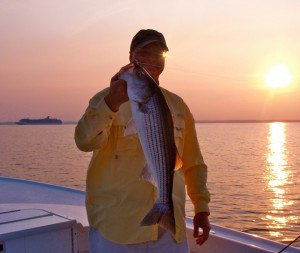 Channel catfish at Hackett’s Bar, carp at the Bay Bridge, snakeheads in St. Jerome’s Creek, and very few stripers in their usual haunts around Kent Island – what’s up with all this late-spring craziness in the Chesapeake Bay? Most fishermen are blaming salt, or more specifically, a lack thereof. Very wet weather in the Susquehanna River watershed has meant lots of fresh water entering the Bay. It’s highly unusual for the Bay to be this fresh in June. Some stations are reporting the lowest readings in recorded history. Salinity is expressed in parts per thousand (ppt), in other words, the number of grams of dissolved salts present in 1,000 grams of water. The water in the Atlantic Ocean is about 35 ppt. Surface salinity today at the Gooses Reef Buoy in the Mid-Chesapeake Bay is 2.0 ppt. That’s low! For better striped bass fishing, we need more salt.
Channel catfish at Hackett’s Bar, carp at the Bay Bridge, snakeheads in St. Jerome’s Creek, and very few stripers in their usual haunts around Kent Island – what’s up with all this late-spring craziness in the Chesapeake Bay? Most fishermen are blaming salt, or more specifically, a lack thereof. Very wet weather in the Susquehanna River watershed has meant lots of fresh water entering the Bay. It’s highly unusual for the Bay to be this fresh in June. Some stations are reporting the lowest readings in recorded history. Salinity is expressed in parts per thousand (ppt), in other words, the number of grams of dissolved salts present in 1,000 grams of water. The water in the Atlantic Ocean is about 35 ppt. Surface salinity today at the Gooses Reef Buoy in the Mid-Chesapeake Bay is 2.0 ppt. That’s low! For better striped bass fishing, we need more salt.
Fishermen have long recognized the importance of locating comfort zones where fish prefer to stay, but sometimes that isn’t so easy. Fishing in late May and early June is usually a challenge, but low salinity levels have made it especially difficult this year. Complicating the matter is that he water can be a lot saltier on the bottom of the Bay than it is on top this time of year. Since, in addition to surface observations, The Gooses Reef Buoy also provides salinity readings from the bottom of the Bay, we can see that it’s currently 7.1 ppt. That’s over three times saltier than it is on the surface. Read More!
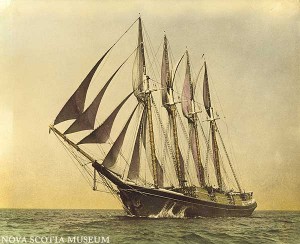 At 7:00 PM on the evening of March 15th, 1912, the four-masted schooner Herbert D. Maxwell left her anchorage near the mouth of the Magothy River and sailed southeast across the Chesapeake Bay toward Kent Island. Built in Maine and designed to haul lumber, the 186 foot cargo ship carried 1150 tons of fertilizer from Baltimore bound for Wilmington, North Carolina. At her helm was her captain and master, William Quillan accompanied by his brother Elay and first mate J.C. Scott. She carried an additional crew of six deck hands. Since winds were mostly calm, it had been slow going down the Chesapeake. After a drowsy sail to just south of Sandy Point, the wind completely died causing Captain Quillan to drop anchor once again. The crew slept until roused by a building northeast breeze at 3:00 AM. Quillan gave the order to the mate to get underway. After pulling anchor and setting sail, The Maxwell ran under clear skies before a 15-knot wind for about 40 minutes when her lookout made an ominous call, “Lights of a steamer, dead-on ahead!” Three minutes later, at 4:44 AM on March 16th, the wooden schooner was ripped apart by the 3200-ton northbound steamship S.S. Gloucester. She sank quickly carrying the first mate and three other crew members to their deaths. Read More!
At 7:00 PM on the evening of March 15th, 1912, the four-masted schooner Herbert D. Maxwell left her anchorage near the mouth of the Magothy River and sailed southeast across the Chesapeake Bay toward Kent Island. Built in Maine and designed to haul lumber, the 186 foot cargo ship carried 1150 tons of fertilizer from Baltimore bound for Wilmington, North Carolina. At her helm was her captain and master, William Quillan accompanied by his brother Elay and first mate J.C. Scott. She carried an additional crew of six deck hands. Since winds were mostly calm, it had been slow going down the Chesapeake. After a drowsy sail to just south of Sandy Point, the wind completely died causing Captain Quillan to drop anchor once again. The crew slept until roused by a building northeast breeze at 3:00 AM. Quillan gave the order to the mate to get underway. After pulling anchor and setting sail, The Maxwell ran under clear skies before a 15-knot wind for about 40 minutes when her lookout made an ominous call, “Lights of a steamer, dead-on ahead!” Three minutes later, at 4:44 AM on March 16th, the wooden schooner was ripped apart by the 3200-ton northbound steamship S.S. Gloucester. She sank quickly carrying the first mate and three other crew members to their deaths. Read More!
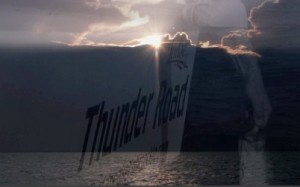 At any given moment there are over 2000 thunderstorms going on around the world. Lately, it seems like most of those are rolling across the Chesapeake. I’ve had several opportunities to fish through the weekend and most of my short trips involved storm dodging. The fishing has been about as unstable as the weather. I’ve taken a couple of complete skunks, had some so-so trips, and finished the weekend with a very successful but somewhat precarious Sunday-evening excursion with Rich and Jamie. We haven’t found a bite in the Upper Bay yet, but the fishing is trying to turn on to the south and east of Kent Island. Most fish are feeding over humps and ledges in the 16-25 foot range, especially over hard oyster bottoms. There is also a decent top-water bite in the shallows at places where the current is visibly moving and fish can find quick access to deeper water. Perch and hard-heads are also lighting up the hard bottoms and can be caught with small metal jigs or scented soft plastic grubs. The water remains very stained. Skies are supposed to be unstable throughout this week. Full-moon currents are ripping so light tackle casting should be pretty good if we can dodge the lightning. Here’s a 2-minute photo montage of our thunder-laced trip Sunday evening trip.
At any given moment there are over 2000 thunderstorms going on around the world. Lately, it seems like most of those are rolling across the Chesapeake. I’ve had several opportunities to fish through the weekend and most of my short trips involved storm dodging. The fishing has been about as unstable as the weather. I’ve taken a couple of complete skunks, had some so-so trips, and finished the weekend with a very successful but somewhat precarious Sunday-evening excursion with Rich and Jamie. We haven’t found a bite in the Upper Bay yet, but the fishing is trying to turn on to the south and east of Kent Island. Most fish are feeding over humps and ledges in the 16-25 foot range, especially over hard oyster bottoms. There is also a decent top-water bite in the shallows at places where the current is visibly moving and fish can find quick access to deeper water. Perch and hard-heads are also lighting up the hard bottoms and can be caught with small metal jigs or scented soft plastic grubs. The water remains very stained. Skies are supposed to be unstable throughout this week. Full-moon currents are ripping so light tackle casting should be pretty good if we can dodge the lightning. Here’s a 2-minute photo montage of our thunder-laced trip Sunday evening trip.
Read More!
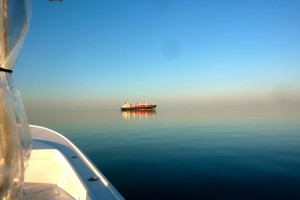 It’s been a windy December, so rough lately that it’s been hard to get out and fish. After yet another strong nor’easter blew through this week, the wind finally came down. Hoping for some cold weather catch & release action, my son Daniel and I broke the ice Wednesday and launched Thunder Road at the Shipping Creek ramp on Kent Island to do some Mid-Bay exploring. We didn’t find many fish – one twenty-four-inch striper to be exact – but we enjoyed our time on the water. The Chesapeake was as flat as I’ve ever seen it. We could see for miles across the glass. In places where we could get an unobstructed view of the horizon, we couldn’t tell where the water ended and the blue sky began. I’ve noticed that the waters of the Bay seem calmer and bluer on cold winter days. Sometimes I think I can see farther this time of year. It turns out there’s an interesting scientific explanation. Read More!
It’s been a windy December, so rough lately that it’s been hard to get out and fish. After yet another strong nor’easter blew through this week, the wind finally came down. Hoping for some cold weather catch & release action, my son Daniel and I broke the ice Wednesday and launched Thunder Road at the Shipping Creek ramp on Kent Island to do some Mid-Bay exploring. We didn’t find many fish – one twenty-four-inch striper to be exact – but we enjoyed our time on the water. The Chesapeake was as flat as I’ve ever seen it. We could see for miles across the glass. In places where we could get an unobstructed view of the horizon, we couldn’t tell where the water ended and the blue sky began. I’ve noticed that the waters of the Bay seem calmer and bluer on cold winter days. Sometimes I think I can see farther this time of year. It turns out there’s an interesting scientific explanation. Read More!
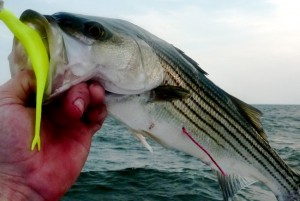 In a recent report I mentioned that I caught a tagged fish. It wasn’t the first fish with a tag I’ve caught on the Chesapeake – I’ve managed to land four previously – but it was the first time I felt like I knew exactly what to do. Despite my participation in conservation associations and advisory groups, it’s taken me four years to figure out how to properly handle a tagged fish caught in the Bay. Apparently I’m not alone because I’ve heard from some other experienced anglers who don’t fully understand the process either. The problem is, there are several organizations that are actively tagging fish, and the rules for each are somewhat different. For example, a pink tag on the left side belly of a striped bass is put there by the Department of the Interior’s Fish & Wildlife Service. I now know you can cut this tag off, measure, and release the fish. However, I hope you aren’t color blind because if that tag you cut off turns out to be chartreuse, you just disqualified yourself from the chance to win $25,000.00. It gets even more confusing. Read More!
In a recent report I mentioned that I caught a tagged fish. It wasn’t the first fish with a tag I’ve caught on the Chesapeake – I’ve managed to land four previously – but it was the first time I felt like I knew exactly what to do. Despite my participation in conservation associations and advisory groups, it’s taken me four years to figure out how to properly handle a tagged fish caught in the Bay. Apparently I’m not alone because I’ve heard from some other experienced anglers who don’t fully understand the process either. The problem is, there are several organizations that are actively tagging fish, and the rules for each are somewhat different. For example, a pink tag on the left side belly of a striped bass is put there by the Department of the Interior’s Fish & Wildlife Service. I now know you can cut this tag off, measure, and release the fish. However, I hope you aren’t color blind because if that tag you cut off turns out to be chartreuse, you just disqualified yourself from the chance to win $25,000.00. It gets even more confusing. Read More!


